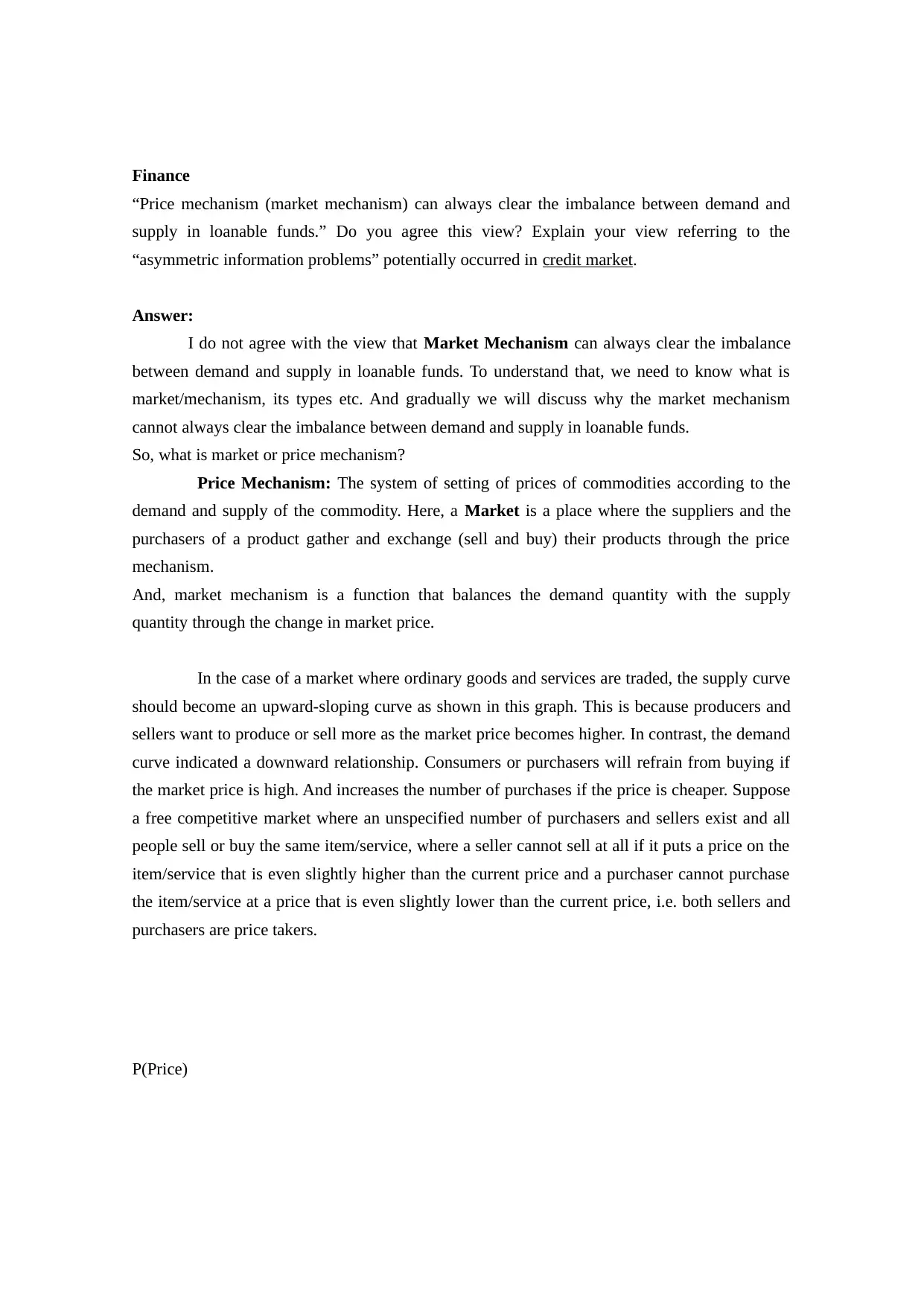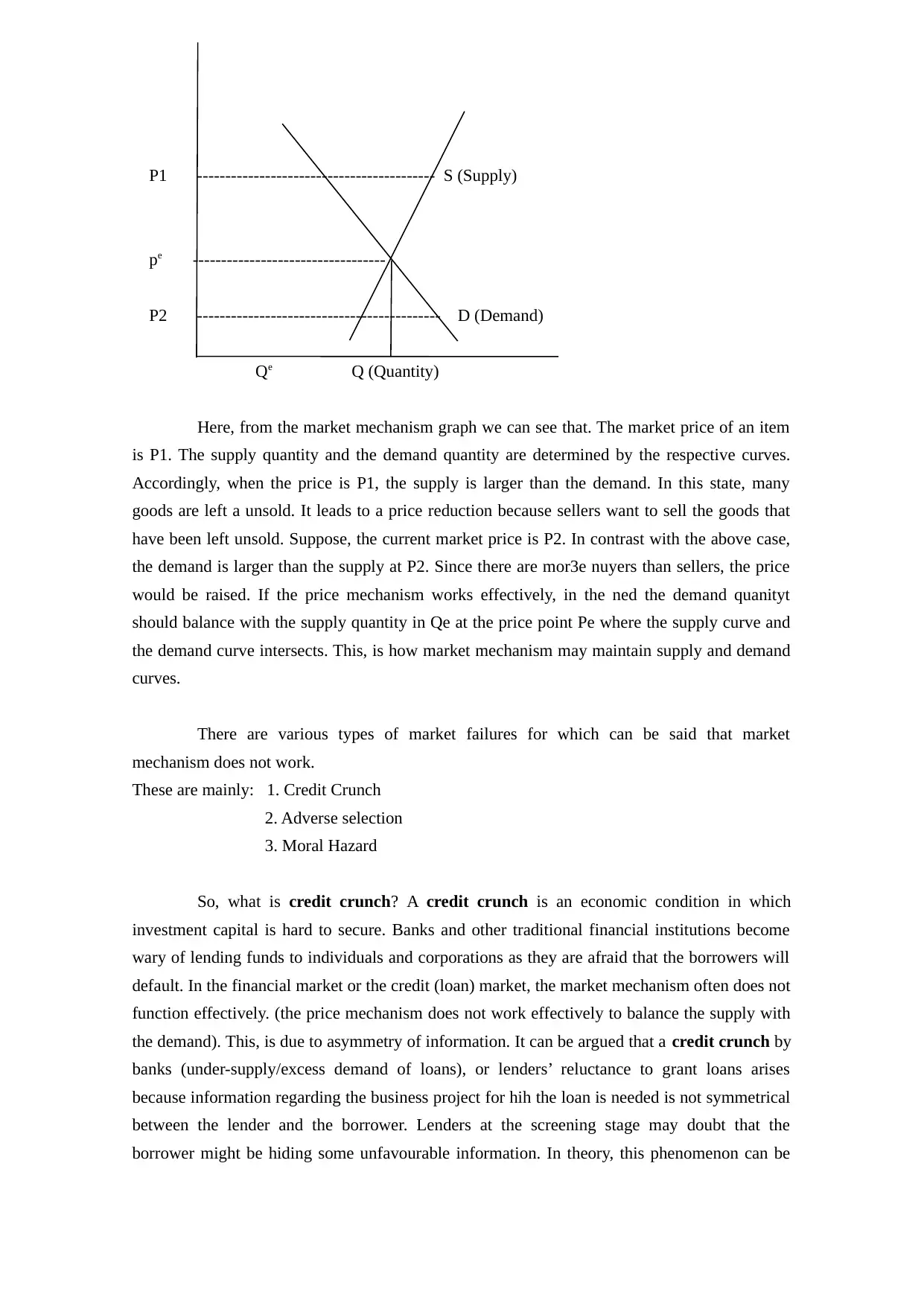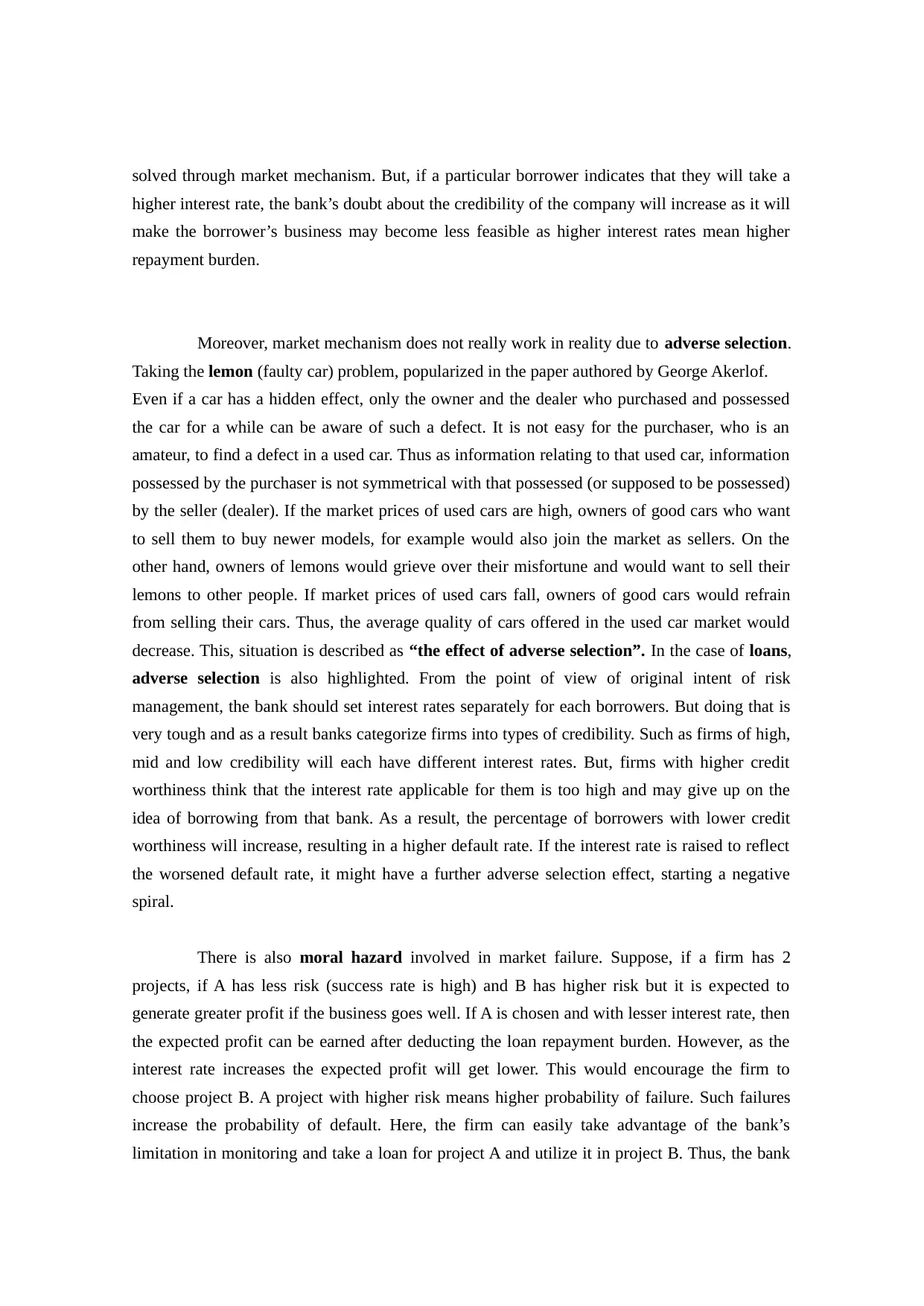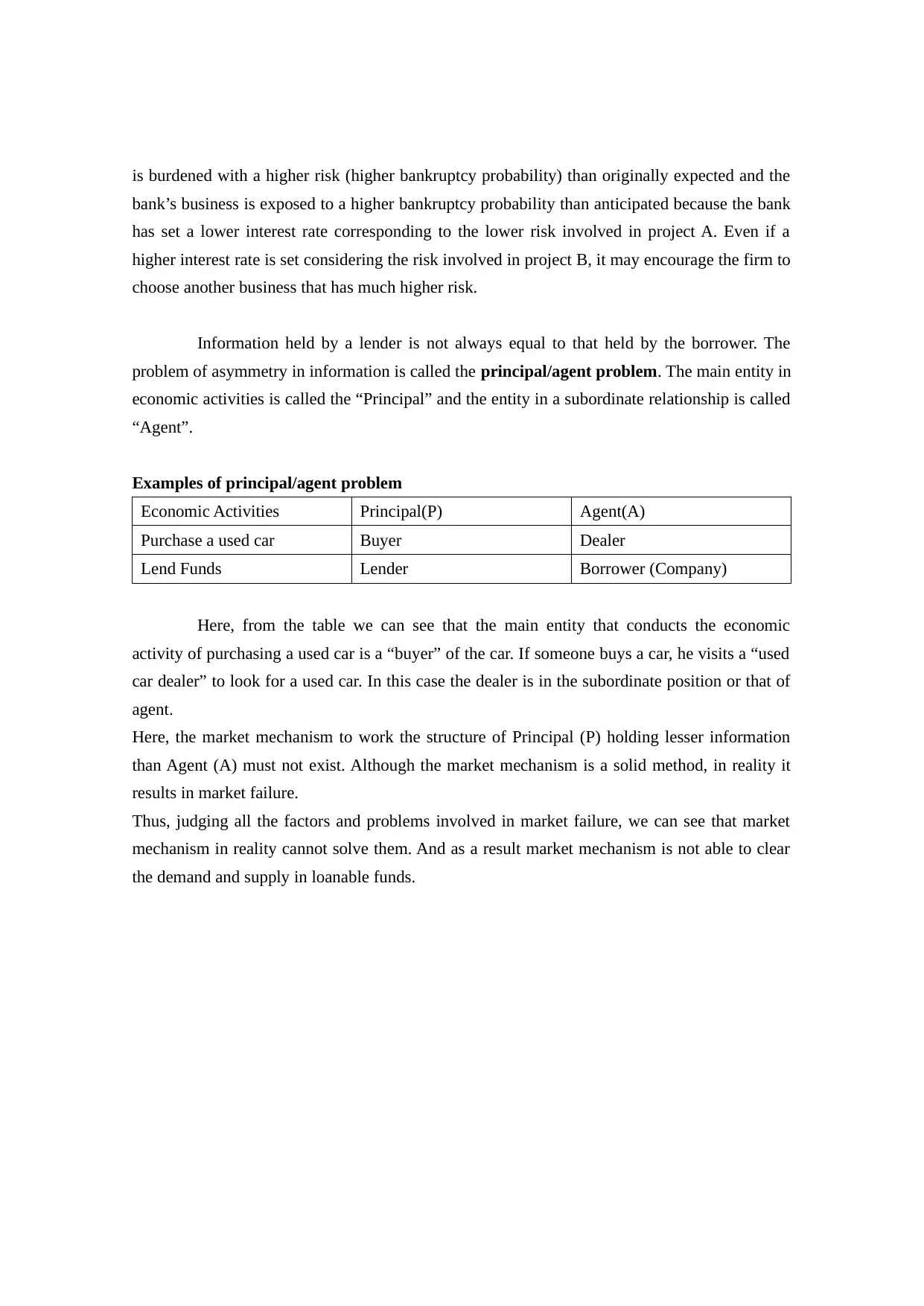Finance: Market Mechanism, Loanable Funds, and Information Problems
VerifiedAdded on 2021/07/28
|4
|1704
|75
Essay
AI Summary
This essay critically examines the effectiveness of the price mechanism in clearing imbalances between the demand and supply of loanable funds. It begins by defining the market mechanism and its theoretical function in balancing supply and demand through price adjustments. The essay then argues against the view that the market mechanism always clears these imbalances, focusing on the credit market. It identifies several market failures, including credit crunches, adverse selection, and moral hazard, which arise due to asymmetric information. The essay explains how these information asymmetries, where lenders and borrowers have unequal access to information, can lead to market inefficiencies. It provides examples such as the 'lemon problem' in used car markets and how these problems manifest in the loan market. The essay further explores the principal-agent problem and concludes that the market mechanism is often insufficient to address these failures, ultimately hindering its ability to clear the loanable funds market.

Finance
“Price mechanism (market mechanism) can always clear the imbalance between demand and
supply in loanable funds.” Do you agree this view? Explain your view referring to the
“asymmetric information problems” potentially occurred in credit market.
Answer:
I do not agree with the view that Market Mechanism can always clear the imbalance
between demand and supply in loanable funds. To understand that, we need to know what is
market/mechanism, its types etc. And gradually we will discuss why the market mechanism
cannot always clear the imbalance between demand and supply in loanable funds.
So, what is market or price mechanism?
Price Mechanism: The system of setting of prices of commodities according to the
demand and supply of the commodity. Here, a Market is a place where the suppliers and the
purchasers of a product gather and exchange (sell and buy) their products through the price
mechanism.
And, market mechanism is a function that balances the demand quantity with the supply
quantity through the change in market price.
In the case of a market where ordinary goods and services are traded, the supply curve
should become an upward-sloping curve as shown in this graph. This is because producers and
sellers want to produce or sell more as the market price becomes higher. In contrast, the demand
curve indicated a downward relationship. Consumers or purchasers will refrain from buying if
the market price is high. And increases the number of purchases if the price is cheaper. Suppose
a free competitive market where an unspecified number of purchasers and sellers exist and all
people sell or buy the same item/service, where a seller cannot sell at all if it puts a price on the
item/service that is even slightly higher than the current price and a purchaser cannot purchase
the item/service at a price that is even slightly lower than the current price, i.e. both sellers and
purchasers are price takers.
P(Price)
“Price mechanism (market mechanism) can always clear the imbalance between demand and
supply in loanable funds.” Do you agree this view? Explain your view referring to the
“asymmetric information problems” potentially occurred in credit market.
Answer:
I do not agree with the view that Market Mechanism can always clear the imbalance
between demand and supply in loanable funds. To understand that, we need to know what is
market/mechanism, its types etc. And gradually we will discuss why the market mechanism
cannot always clear the imbalance between demand and supply in loanable funds.
So, what is market or price mechanism?
Price Mechanism: The system of setting of prices of commodities according to the
demand and supply of the commodity. Here, a Market is a place where the suppliers and the
purchasers of a product gather and exchange (sell and buy) their products through the price
mechanism.
And, market mechanism is a function that balances the demand quantity with the supply
quantity through the change in market price.
In the case of a market where ordinary goods and services are traded, the supply curve
should become an upward-sloping curve as shown in this graph. This is because producers and
sellers want to produce or sell more as the market price becomes higher. In contrast, the demand
curve indicated a downward relationship. Consumers or purchasers will refrain from buying if
the market price is high. And increases the number of purchases if the price is cheaper. Suppose
a free competitive market where an unspecified number of purchasers and sellers exist and all
people sell or buy the same item/service, where a seller cannot sell at all if it puts a price on the
item/service that is even slightly higher than the current price and a purchaser cannot purchase
the item/service at a price that is even slightly lower than the current price, i.e. both sellers and
purchasers are price takers.
P(Price)
Paraphrase This Document
Need a fresh take? Get an instant paraphrase of this document with our AI Paraphraser

P1 ------------------------------------------ S (Supply)
pe ----------------------------------
P2 ------------------------------------------- D (Demand)
Qe Q (Quantity)
Here, from the market mechanism graph we can see that. The market price of an item
is P1. The supply quantity and the demand quantity are determined by the respective curves.
Accordingly, when the price is P1, the supply is larger than the demand. In this state, many
goods are left a unsold. It leads to a price reduction because sellers want to sell the goods that
have been left unsold. Suppose, the current market price is P2. In contrast with the above case,
the demand is larger than the supply at P2. Since there are mor3e nuyers than sellers, the price
would be raised. If the price mechanism works effectively, in the ned the demand quanityt
should balance with the supply quantity in Qe at the price point Pe where the supply curve and
the demand curve intersects. This, is how market mechanism may maintain supply and demand
curves.
There are various types of market failures for which can be said that market
mechanism does not work.
These are mainly: 1. Credit Crunch
2. Adverse selection
3. Moral Hazard
So, what is credit crunch? A credit crunch is an economic condition in which
investment capital is hard to secure. Banks and other traditional financial institutions become
wary of lending funds to individuals and corporations as they are afraid that the borrowers will
default. In the financial market or the credit (loan) market, the market mechanism often does not
function effectively. (the price mechanism does not work effectively to balance the supply with
the demand). This, is due to asymmetry of information. It can be argued that a credit crunch by
banks (under-supply/excess demand of loans), or lenders’ reluctance to grant loans arises
because information regarding the business project for hih the loan is needed is not symmetrical
between the lender and the borrower. Lenders at the screening stage may doubt that the
borrower might be hiding some unfavourable information. In theory, this phenomenon can be
pe ----------------------------------
P2 ------------------------------------------- D (Demand)
Qe Q (Quantity)
Here, from the market mechanism graph we can see that. The market price of an item
is P1. The supply quantity and the demand quantity are determined by the respective curves.
Accordingly, when the price is P1, the supply is larger than the demand. In this state, many
goods are left a unsold. It leads to a price reduction because sellers want to sell the goods that
have been left unsold. Suppose, the current market price is P2. In contrast with the above case,
the demand is larger than the supply at P2. Since there are mor3e nuyers than sellers, the price
would be raised. If the price mechanism works effectively, in the ned the demand quanityt
should balance with the supply quantity in Qe at the price point Pe where the supply curve and
the demand curve intersects. This, is how market mechanism may maintain supply and demand
curves.
There are various types of market failures for which can be said that market
mechanism does not work.
These are mainly: 1. Credit Crunch
2. Adverse selection
3. Moral Hazard
So, what is credit crunch? A credit crunch is an economic condition in which
investment capital is hard to secure. Banks and other traditional financial institutions become
wary of lending funds to individuals and corporations as they are afraid that the borrowers will
default. In the financial market or the credit (loan) market, the market mechanism often does not
function effectively. (the price mechanism does not work effectively to balance the supply with
the demand). This, is due to asymmetry of information. It can be argued that a credit crunch by
banks (under-supply/excess demand of loans), or lenders’ reluctance to grant loans arises
because information regarding the business project for hih the loan is needed is not symmetrical
between the lender and the borrower. Lenders at the screening stage may doubt that the
borrower might be hiding some unfavourable information. In theory, this phenomenon can be

solved through market mechanism. But, if a particular borrower indicates that they will take a
higher interest rate, the bank’s doubt about the credibility of the company will increase as it will
make the borrower’s business may become less feasible as higher interest rates mean higher
repayment burden.
Moreover, market mechanism does not really work in reality due to adverse selection.
Taking the lemon (faulty car) problem, popularized in the paper authored by George Akerlof.
Even if a car has a hidden effect, only the owner and the dealer who purchased and possessed
the car for a while can be aware of such a defect. It is not easy for the purchaser, who is an
amateur, to find a defect in a used car. Thus as information relating to that used car, information
possessed by the purchaser is not symmetrical with that possessed (or supposed to be possessed)
by the seller (dealer). If the market prices of used cars are high, owners of good cars who want
to sell them to buy newer models, for example would also join the market as sellers. On the
other hand, owners of lemons would grieve over their misfortune and would want to sell their
lemons to other people. If market prices of used cars fall, owners of good cars would refrain
from selling their cars. Thus, the average quality of cars offered in the used car market would
decrease. This, situation is described as “the effect of adverse selection”. In the case of loans,
adverse selection is also highlighted. From the point of view of original intent of risk
management, the bank should set interest rates separately for each borrowers. But doing that is
very tough and as a result banks categorize firms into types of credibility. Such as firms of high,
mid and low credibility will each have different interest rates. But, firms with higher credit
worthiness think that the interest rate applicable for them is too high and may give up on the
idea of borrowing from that bank. As a result, the percentage of borrowers with lower credit
worthiness will increase, resulting in a higher default rate. If the interest rate is raised to reflect
the worsened default rate, it might have a further adverse selection effect, starting a negative
spiral.
There is also moral hazard involved in market failure. Suppose, if a firm has 2
projects, if A has less risk (success rate is high) and B has higher risk but it is expected to
generate greater profit if the business goes well. If A is chosen and with lesser interest rate, then
the expected profit can be earned after deducting the loan repayment burden. However, as the
interest rate increases the expected profit will get lower. This would encourage the firm to
choose project B. A project with higher risk means higher probability of failure. Such failures
increase the probability of default. Here, the firm can easily take advantage of the bank’s
limitation in monitoring and take a loan for project A and utilize it in project B. Thus, the bank
higher interest rate, the bank’s doubt about the credibility of the company will increase as it will
make the borrower’s business may become less feasible as higher interest rates mean higher
repayment burden.
Moreover, market mechanism does not really work in reality due to adverse selection.
Taking the lemon (faulty car) problem, popularized in the paper authored by George Akerlof.
Even if a car has a hidden effect, only the owner and the dealer who purchased and possessed
the car for a while can be aware of such a defect. It is not easy for the purchaser, who is an
amateur, to find a defect in a used car. Thus as information relating to that used car, information
possessed by the purchaser is not symmetrical with that possessed (or supposed to be possessed)
by the seller (dealer). If the market prices of used cars are high, owners of good cars who want
to sell them to buy newer models, for example would also join the market as sellers. On the
other hand, owners of lemons would grieve over their misfortune and would want to sell their
lemons to other people. If market prices of used cars fall, owners of good cars would refrain
from selling their cars. Thus, the average quality of cars offered in the used car market would
decrease. This, situation is described as “the effect of adverse selection”. In the case of loans,
adverse selection is also highlighted. From the point of view of original intent of risk
management, the bank should set interest rates separately for each borrowers. But doing that is
very tough and as a result banks categorize firms into types of credibility. Such as firms of high,
mid and low credibility will each have different interest rates. But, firms with higher credit
worthiness think that the interest rate applicable for them is too high and may give up on the
idea of borrowing from that bank. As a result, the percentage of borrowers with lower credit
worthiness will increase, resulting in a higher default rate. If the interest rate is raised to reflect
the worsened default rate, it might have a further adverse selection effect, starting a negative
spiral.
There is also moral hazard involved in market failure. Suppose, if a firm has 2
projects, if A has less risk (success rate is high) and B has higher risk but it is expected to
generate greater profit if the business goes well. If A is chosen and with lesser interest rate, then
the expected profit can be earned after deducting the loan repayment burden. However, as the
interest rate increases the expected profit will get lower. This would encourage the firm to
choose project B. A project with higher risk means higher probability of failure. Such failures
increase the probability of default. Here, the firm can easily take advantage of the bank’s
limitation in monitoring and take a loan for project A and utilize it in project B. Thus, the bank
⊘ This is a preview!⊘
Do you want full access?
Subscribe today to unlock all pages.

Trusted by 1+ million students worldwide

is burdened with a higher risk (higher bankruptcy probability) than originally expected and the
bank’s business is exposed to a higher bankruptcy probability than anticipated because the bank
has set a lower interest rate corresponding to the lower risk involved in project A. Even if a
higher interest rate is set considering the risk involved in project B, it may encourage the firm to
choose another business that has much higher risk.
Information held by a lender is not always equal to that held by the borrower. The
problem of asymmetry in information is called the principal/agent problem. The main entity in
economic activities is called the “Principal” and the entity in a subordinate relationship is called
“Agent”.
Examples of principal/agent problem
Economic Activities Principal(P) Agent(A)
Purchase a used car Buyer Dealer
Lend Funds Lender Borrower (Company)
Here, from the table we can see that the main entity that conducts the economic
activity of purchasing a used car is a “buyer” of the car. If someone buys a car, he visits a “used
car dealer” to look for a used car. In this case the dealer is in the subordinate position or that of
agent.
Here, the market mechanism to work the structure of Principal (P) holding lesser information
than Agent (A) must not exist. Although the market mechanism is a solid method, in reality it
results in market failure.
Thus, judging all the factors and problems involved in market failure, we can see that market
mechanism in reality cannot solve them. And as a result market mechanism is not able to clear
the demand and supply in loanable funds.
bank’s business is exposed to a higher bankruptcy probability than anticipated because the bank
has set a lower interest rate corresponding to the lower risk involved in project A. Even if a
higher interest rate is set considering the risk involved in project B, it may encourage the firm to
choose another business that has much higher risk.
Information held by a lender is not always equal to that held by the borrower. The
problem of asymmetry in information is called the principal/agent problem. The main entity in
economic activities is called the “Principal” and the entity in a subordinate relationship is called
“Agent”.
Examples of principal/agent problem
Economic Activities Principal(P) Agent(A)
Purchase a used car Buyer Dealer
Lend Funds Lender Borrower (Company)
Here, from the table we can see that the main entity that conducts the economic
activity of purchasing a used car is a “buyer” of the car. If someone buys a car, he visits a “used
car dealer” to look for a used car. In this case the dealer is in the subordinate position or that of
agent.
Here, the market mechanism to work the structure of Principal (P) holding lesser information
than Agent (A) must not exist. Although the market mechanism is a solid method, in reality it
results in market failure.
Thus, judging all the factors and problems involved in market failure, we can see that market
mechanism in reality cannot solve them. And as a result market mechanism is not able to clear
the demand and supply in loanable funds.
1 out of 4
Related Documents
Your All-in-One AI-Powered Toolkit for Academic Success.
+13062052269
info@desklib.com
Available 24*7 on WhatsApp / Email
![[object Object]](/_next/static/media/star-bottom.7253800d.svg)
Unlock your academic potential
Copyright © 2020–2025 A2Z Services. All Rights Reserved. Developed and managed by ZUCOL.





